英文摘要页示例
西南交通大学研究生学位论文撰写规范(新版)
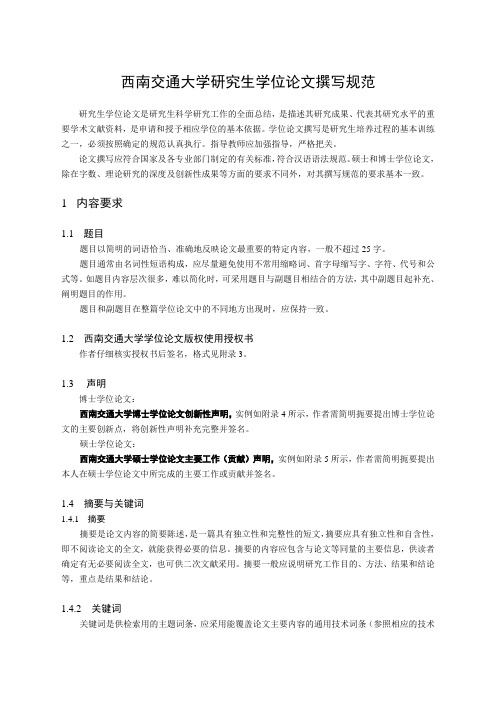
西南交通大学研究生学位论文撰写规范研究生学位论文是研究生科学研究工作的全面总结,是描述其研究成果、代表其研究水平的重要学术文献资料,是申请和授予相应学位的基本依据。
学位论文撰写是研究生培养过程的基本训练之一,必须按照确定的规范认真执行。
指导教师应加强指导,严格把关。
论文撰写应符合国家及各专业部门制定的有关标准,符合汉语语法规范。
硕士和博士学位论文,除在字数、理论研究的深度及创新性成果等方面的要求不同外,对其撰写规范的要求基本一致。
1内容要求1.1 题目题目以简明的词语恰当、准确地反映论文最重要的特定内容,一般不超过25字。
题目通常由名词性短语构成,应尽量避免使用不常用缩略词、首字母缩写字、字符、代号和公式等。
如题目内容层次很多,难以简化时,可采用题目与副题目相结合的方法,其中副题目起补充、阐明题目的作用。
题目和副题目在整篇学位论文中的不同地方出现时,应保持一致。
1.2 西南交通大学学位论文版权使用授权书作者仔细核实授权书后签名,格式见附录3。
1.3声明博士学位论文:西南交通大学博士学位论文创新性声明,实例如附录4所示,作者需简明扼要提出博士学位论文的主要创新点,将创新性声明补充完整并签名。
硕士学位论文:西南交通大学硕士学位论文主要工作(贡献)声明,实例如附录5所示,作者需简明扼要提出本人在硕士学位论文中所完成的主要工作或贡献并签名。
1.4 摘要与关键词1.4.1 摘要摘要是论文内容的简要陈述,是一篇具有独立性和完整性的短文,摘要应具有独立性和自含性,即不阅读论文的全文,就能获得必要的信息。
摘要的内容应包含与论文等同量的主要信息,供读者确定有无必要阅读全文,也可供二次文献采用。
摘要一般应说明研究工作目的、方法、结果和结论等,重点是结果和结论。
1.4.2 关键词关键词是供检索用的主题词条,应采用能覆盖论文主要内容的通用技术词条(参照相应的技术术语标准)。
关键词一般列3~8个,用显著的字符号另起一行,排在摘要的下方。
论文及英文翻译格式
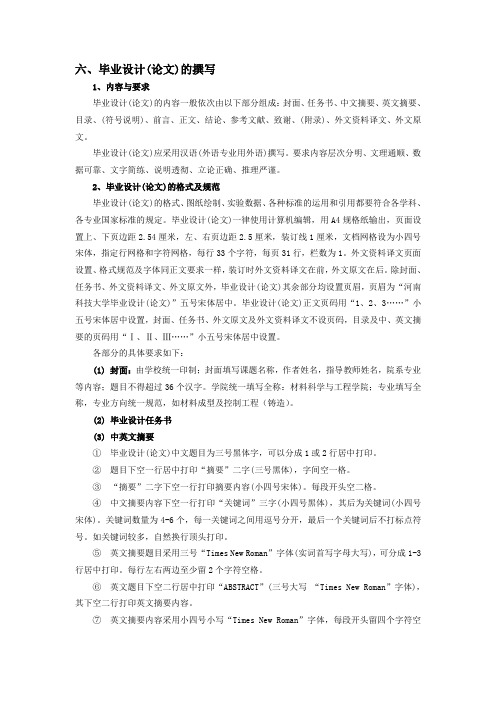
六、毕业设计(论文)的撰写1、内容与要求毕业设计(论文)的内容一般依次由以下部分组成:封面、任务书、中文摘要、英文摘要、目录、(符号说明)、前言、正文、结论、参考文献、致谢、(附录)、外文资料译文、外文原文。
毕业设计(论文)应采用汉语(外语专业用外语)撰写。
要求内容层次分明、文理通顺、数据可靠、文字简练、说明透彻、立论正确、推理严谨。
2、毕业设计(论文)的格式及规范毕业设计(论文)的格式、图纸绘制、实验数据、各种标准的运用和引用都要符合各学科、各专业国家标准的规定。
毕业设计(论文)一律使用计算机编辑,用A4规格纸输出,页面设置上、下页边距2.54厘米,左、右页边距2.5厘米,装订线1厘米,文档网格设为小四号宋体,指定行网格和字符网格,每行33个字符,每页31行,栏数为1。
外文资料译文页面设置、格式规范及字体同正文要求一样,装订时外文资料译文在前,外文原文在后。
除封面、任务书、外文资料译文、外文原文外,毕业设计(论文)其余部分均设置页眉,页眉为“河南科技大学毕业设计(论文)”五号宋体居中。
毕业设计(论文)正文页码用“1、2、3……”小五号宋体居中设置,封面、任务书、外文原文及外文资料译文不设页码,目录及中、英文摘要的页码用“Ⅰ、Ⅱ、Ⅲ……”小五号宋体居中设置。
各部分的具体要求如下:(1) 封面:由学校统一印制;封面填写课题名称,作者姓名,指导教师姓名,院系专业等内容;题目不得超过36个汉字。
学院统一填写全称:材料科学与工程学院;专业填写全称,专业方向统一规范,如材料成型及控制工程(铸造)。
(2) 毕业设计任务书(3) 中英文摘要①毕业设计(论文)中文题目为三号黑体字,可以分成1或2行居中打印。
②题目下空一行居中打印“摘要”二字(三号黑体),字间空一格。
③“摘要”二字下空一行打印摘要内容(小四号宋体)。
每段开头空二格。
④中文摘要内容下空一行打印“关键词”三字(小四号黑体),其后为关键词(小四号宋体)。
附录1封面示例
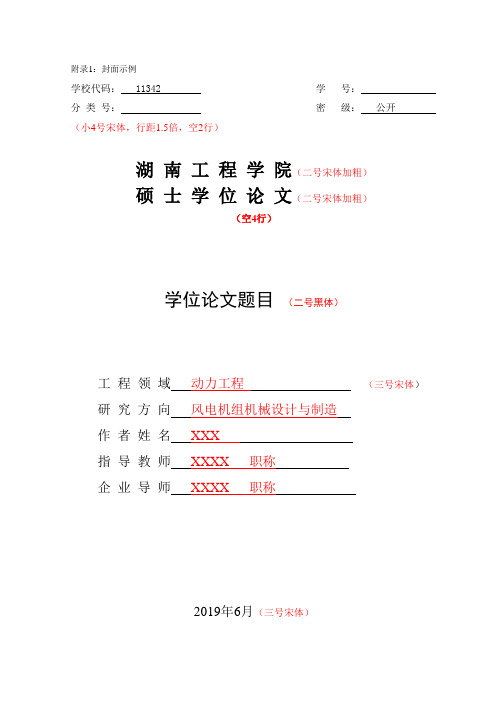
附录1:封面示例学校代码: 11342 学号:分类号:密级:公开(小4号宋体,行距1.5倍,空2行)湖南工程学院(二号宋体加粗)硕士学位论文(二号宋体加粗)(空4行)学位论文题目(二号黑体)工程领域动力工程(三号宋体)研究方向风电机组机械设计与制造作者姓名XXX指导教师XXXX 职称企业导师XXXX 职称2019年6月(三号宋体)附录2:扉页示例(中文)(空3行,行距1.5倍)学位论文题目(二号黑体)工程领域(三号宋体)研究方向作者姓名指导教师企业导师(空6行)湖南工程学院(三号宋体)答辩日期:2019年6月附录3:扉页示例(英文)(空3行,行距1.5倍)(此处为论文题目的外文译文、全部大写、Times New Roman 2 号字)(以下各项字体为Times New Roman 4 号字体)SpecialityCandidate Xiaoxiao WangSupervisor Dashan Zhang ProfessorYiyun Wei EngineerHunan Institute of EngineeringJune, 2019(空2行,行距1.5倍)湖南工程学院学位论文版权使用授权书本学位论文作者完全了解学校有关保留、使用学位论文的规定,同意学校保留并向国家有关部门或机构送交论文的复印件和电子版,允许论文被查阅和借阅。
本人授权湖南工程学院可以将本论文的全部或部分内容编入有关数据库进行检索,可以采用影印、缩印或扫描等复印手段保存和汇编本学位论文。
本学位论文属于1.保密□,在年解密后适用本授权书;2.不保密□,使用本授权书。
(请在以上方框内打“√”)学位论文作者签名:指导老师签名:日期:年月日日期:年月日(空2行,行距1.5倍)湖南工程学院学位论文独创性(贡献)声明本人郑重声明:所呈交的学位论文,是在导师指导下独立进行研究工作所得的成果。
除文中已经注明引用的内容外,本论文不包含任何其他个人或集体已经发表或撰写过的研究成果。
学士学位论文格式要求
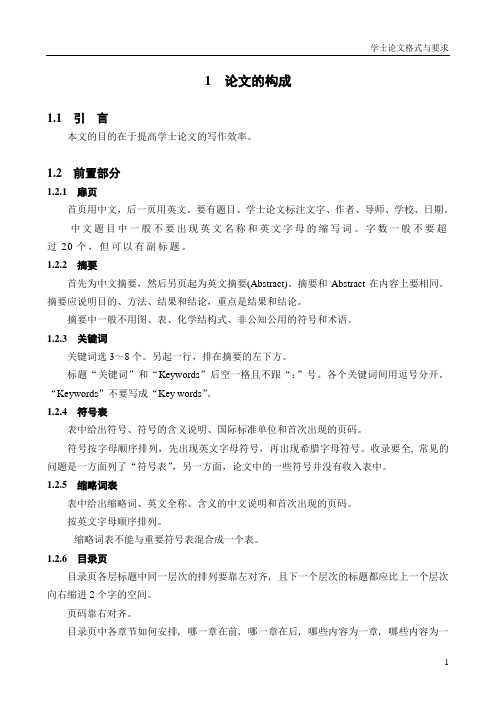
1 论文的构成1.1 引言本文的目的在于提高学士论文的写作效率。
1.2 前置部分1.2.1 扉页首页用中文,后一页用英文。
要有题目、学士论文标注文字、作者、导师、学校、日期。
中文题目中一般不要出现英文名称和英文字母的缩写词。
字数一般不要超过20个,但可以有副标题。
1.2.2摘要首先为中文摘要,然后另页起为英文摘要(Abstract)。
摘要和Abstract在内容上要相同。
摘要应说明目的、方法、结果和结论,重点是结果和结论。
摘要中一般不用图、表、化学结构式、非公知公用的符号和术语。
1.2.3关键词关键词选3~8个。
另起一行,排在摘要的左下方。
标题“关键词”和“Keywords”后空一格且不跟“:”号。
各个关键词间用逗号分开。
“Keywords”不要写成“Key words”。
1.2.4 符号表表中给出符号、符号的含义说明、国际标准单位和首次出现的页码。
符号按字母顺序排列,先出现英文字母符号,再出现希腊字母符号。
收录要全, 常见的问题是一方面列了“符号表”,另一方面,论文中的一些符号并没有收入表中。
1.2.5 缩略词表表中给出缩略词、英文全称、含义的中文说明和首次出现的页码。
按英文字母顺序排列。
缩略词表不能与重要符号表混合成一个表。
1.2.6 目录页目录页各层标题中同一层次的排列要靠左对齐, 且下一个层次的标题都应比上一个层次向右缩进2个字的空间。
页码靠右对齐。
目录页中各章节如何安排, 哪一章在前, 哪一章在后, 哪些内容为一章, 哪些内容为一节, 都必须在写作前与导师商量好, 然后再撰写。
否则一旦导师要求重新编排章节, 这以前的写作时间和精力就被浪费了。
1.3 主体部分1.3.1 一般要求全文要用阿拉伯数字连续编页码。
页码应标注在每页的右下角。
封面、封二、封三和封底不编页码。
将目录页等前置部分(见第1.2节)单独编排页码,用罗马大写数字Ⅰ,Ⅱ,Ⅲ,Ⅳ,Ⅴ,Ⅵ,Ⅶ,Ⅷ,Ⅸ,Ⅹ,Ⅺ,Ⅻ等。
图、表、公式、化学反应式等,用阿拉伯数字分别分章依序、连续编排序号。
5.英文摘要的写法
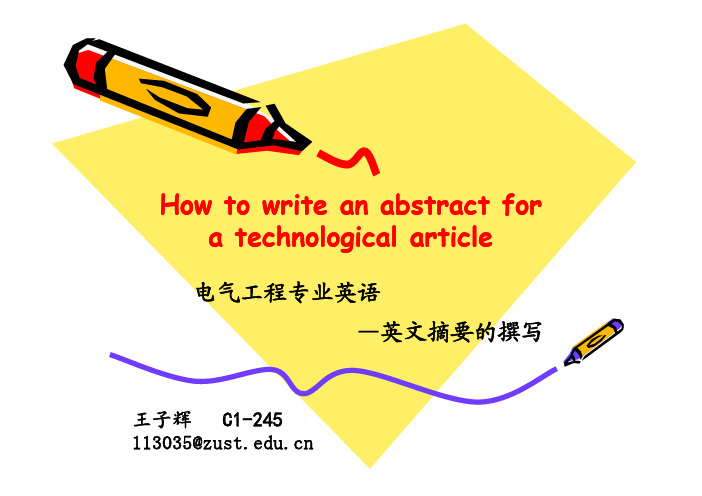
Example 3 范例3 -指示性摘要
一般现在时、一般过去时、现在完成时及其被动语 态
This section highlights early electronics milestones that have made significant contributions to aerospace and defense. Today everyone thinks digital, whereas more than 50% of electronic advances since technology founding 50 years ago were in the analog or continuous domain. It is too easy to forget that before the 1970s and 1980s analog systems had been the norm.
thesis, review, conference proceeding or any in-depth
analysis of a particular subject or discipline, and is often
used to help the reader quickly ascertain the paper‘s
purpose.
abstract 摘要 discipline 学科 ascertain 确定,弄清
article 期刊论文 thesis (学位)论文 review 评论
conference proceeding
会议论文集
摘要是对研究性论文、学位论文、学术评论、会议论文或任 何特定领域和学科分析研究的一种简略的概述,并经常被用 来使读者能够快速了解文章的意图。
研究生毕业论文排版、装订格式要求
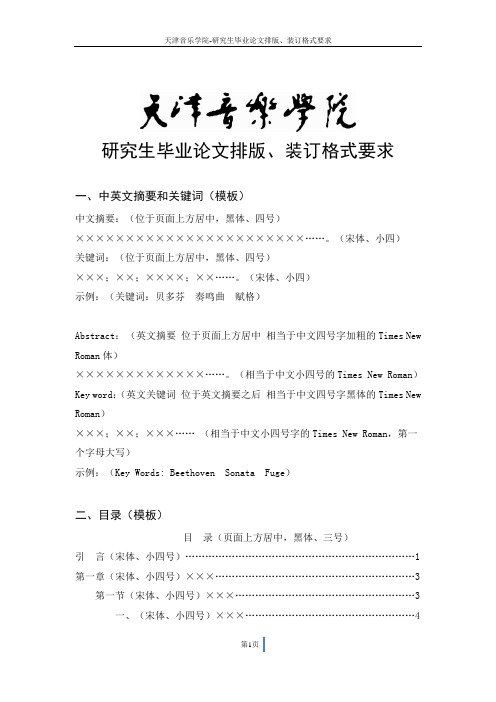
研究生毕业论文排版、装订格式要求一、中英文摘要和关键词(模板)中文摘要:(位于页面上方居中,黑体、四号)×××××××××××××××××××××××……。
(宋体、小四)关键词:(位于页面上方居中,黑体、四号)×××;××;××××;××……。
(宋体、小四)示例:(关键词:贝多芬奏鸣曲赋格)Abstract:(英文摘要位于页面上方居中相当于中文四号字加粗的Times New Roman体)×××××××××××××……。
(相当于中文小四号的Times New Roman)Key word:(英文关键词位于英文摘要之后相当于中文四号字黑体的Times New Roman)×××;××;×××……(相当于中文小四号字的Times New Roman,第一个字母大写)示例:(Key Words: Beethoven Sonata Fuge)二、目录(模板)目录(页面上方居中,黑体、三号)引言(宋体、小四号) (1)第一章(宋体、小四号)××× (3)第一节(宋体、小四号)××× (3)一、(宋体、小四号)××× (4)1. (宋体、小四号)××× (6)二、(宋体、小四号)××× (9)第二章(宋体、小四号)××× (12)第三章(宋体、小四号)××× (18)结论(宋体、小四号) (34)参考文献(宋体、小四号) (36)附录(宋体、小四号) (38)后记(宋体、小四号) (40)论文目录,一般只列到第四级,即“1.2.3.”即可。
史学学位论文参考文献及注释规范(

东北师范大学研究生学位论文规范1. 引言1.1 为了规范我校研究生学位论文的格式,提高论文撰写水平,便于信息系统的收集、存储、处理、加工、检索、利用、交流和传播,特制定本规范;1.2 本规范适用于申请东北师范大学硕士学位、博士学位的学位论文的撰写要求与格式;1.3 本规范参照《中华人民共和国标准科学技术报告、学位论文和学术论文的编写格式》和《中华人民共和国标准文后参考文献著录规则》制定。
2. 学位论文的基本要求2.1 硕士学位论文的基本要求:要求对所研究的课题有新见解或新成果,在理论上或实践上对我国现代化建设或本门学科发展具有一定的意义,并能表明作者在本门学科上掌握了坚实的基础理论和系统的专门知识,具有从事科学研究工作或独立担负专门技术工作的能力。
学位论文应在导师指导下,由硕士研究生本人独立完成。
2.2 博士学位论文的基本要求:要求对所研究的课题在科学上或专门技术上做出创造性成果,并在理论上或实践上对我国现代化建设或本门学科发展具有较重要的意义,表明作者在本门学科上掌握了坚实宽广的基础理论和系统深入的专门知识,具有独立从事科学研究工作的能力。
学位论文应在导师指导下,由博士研究生本人独立完成。
2.3 语言种类:学位论文一般用中文撰写,特殊专业可用英文或其它文字撰写,但论文题目、摘要等必须有中文译注。
2.4 字数要求:理科硕士学位论文字数一般不少于一万,理科博士学位论文字数一般不少于二万;文科硕士学位论文字数不少于二万,文科博士学位论文字数不少于五万。
3. 学位论文书写格式3.1 学位论文的形式结构:博士、硕士学位论文一般应包括以下几部分(按学位论文中先后顺序排列)封面独创性声明、版权使用授权书学前置部分中英文摘要位目录论文引言形正文式主体部分结语结参考文献构附录附录部分后记(包括致谢)在学期间学术成果情况(适用于博士学位论文)3.2 论文封面及首页3.2.1 封面及首页由我校图书馆统一制作,首页内容与格式与封面相同,格式见附件1;3.2.2 学校代码:我校代码为10200;3.2.3 研究生学号:填写研究生证号;无学生证的,填写姓名拼音大写和授予学位年份,例如:王立国2005年被授予学位,则填写WANGLIGUO2005;3.2.4 分类号:按《中国图书资料分类法》一书填写(可到图书馆查询);3.2.5 密级:根据实际情况和导师意见在“无、内部、秘密、机密、绝密”中选择其一填写;有保密要求不宜公开的论文由学生本人提出申请,经导师和学位评定分委员会同意后,提交研究生院学位办公室备案。
中英文论文写作(摘要)
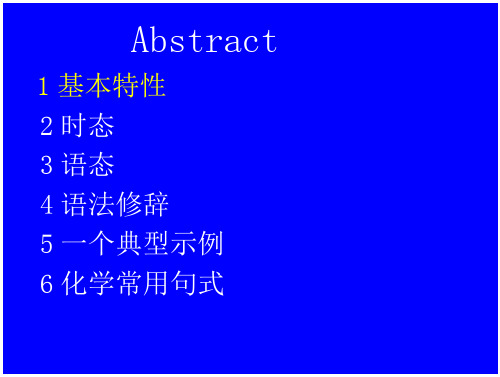
1 基本特性 2 时态 3 语态 4 语法修辞 5 一个典型示例 6 化学常用句式
2 时态
以一般现在时为主, 也使用一般过去时和 现在完成时 从理论上讲: 说法一: 一般现在时
通过科 学实验取得的 研究结果、结 论,揭示自然 界的客观规律 一般过去时
Objective 动词不定式开头 To investigate … To study … To explore … To examine … To determine … To report … To review … 使用第一人称时,用凡指的we, the author, the authors ,不用I。 如: In this paper we conclude …
Result: The contents of the components of midecamyc A1 and leucomycin A6 was 30%~ 50% and 10%~20% respectively, the contents of the rest components w lower, different manufactures produces have differ components. Conclution: To revise the specificati meleumycin for quality control.
指示性文摘(indicative abstract)
This type of abstract is designed to ind the subject of a paper, making it easy fo potential readers to decide whether to r the paper.
英文合同摘要模板
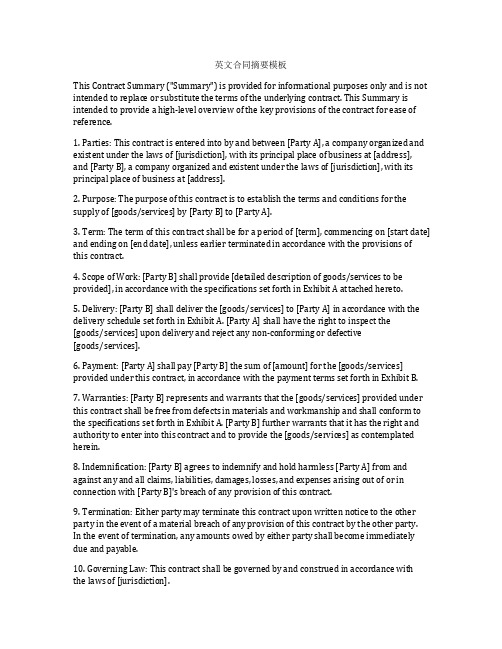
英文合同摘要模板This Contract Summary ("Summary") is provided for informational purposes only and is not intended to replace or substitute the terms of the underlying contract. This Summary is intended to provide a high-level overview of the key provisions of the contract for ease of reference.1. Parties: This contract is entered into by and between [Party A], a company organized and existent under the laws of [jurisdiction], with its principal place of business at [address], and [Party B], a company organized and existent under the laws of [jurisdiction], with its principal place of business at [address].2. Purpose: The purpose of this contract is to establish the terms and conditions for the supply of [goods/services] by [Party B] to [Party A].3. Term: The term of this contract shall be for a period of [term], commencing on [start date] and ending on [end date], unless earlier terminated in accordance with the provisions of this contract.4. Scope of Work: [Party B] shall provide [detailed description of goods/services to be provided], in accordance with the specifications set forth in Exhibit A attached hereto.5. Delivery: [Party B] shall deliver the [goods/services] to [Party A] in accordance with the delivery schedule set forth in Exhibit A. [Party A] shall have the right to inspect the [goods/services] upon delivery and reject any non-conforming or defective[goods/services].6. Payment: [Party A] shall pay [Party B] the sum of [amount] for the [goods/services] provided under this contract, in accordance with the payment terms set forth in Exhibit B.7. Warranties: [Party B] represents and warrants that the [goods/services] provided under this contract shall be free from defects in materials and workmanship and shall conform to the specifications set forth in Exhibit A. [Party B] further warrants that it has the right and authority to enter into this contract and to provide the [goods/services] as contemplated herein.8. Indemnification: [Party B] agrees to indemnify and hold harmless [Party A] from and against any and all claims, liabilities, damages, losses, and expenses arising out of or in connection with [Party B]'s breach of any provision of this contract.9. Termination: Either party may terminate this contract upon written notice to the other party in the event of a material breach of any provision of this contract by the other party.In the event of termination, any amounts owed by either party shall become immediately due and payable.10. Governing Law: This contract shall be governed by and construed in accordance with the laws of [jurisdiction].This Summary is provided for informational purposes only and does not constitute legal advice. Parties to the underlying contract should review the full terms and conditions of the contract before taking any action based on the provisions of this Summary.。
关于计算机的英文文献写作范文摘要

关于计算机的英文文献写作范文摘要全文共10篇示例,供读者参考篇1Title: All About ComputersHey guys! Have you ever wondered how computers work and why they are so important in our daily lives? In this article, we will dive into the fascinating world of computers and learn all about their history, functions, and impact on society.First off, let's talk about the history of computers. Did you know that the first computer was invented in the early 20th century? It was a huge machine that took up an entire room! But over the years, computers have become smaller, faster, and more powerful. Nowadays, we have laptops, tablets, and smartphones that can fit in the palm of our hands.So, what do computers actually do? Well, they can process information, store data, and perform calculations at incredible speeds. This allows us to do all sorts of cool things like play video games, surf the internet, and communicate with people all over the world.But computers aren't just for fun and games – they also play a crucial role in many industries like healthcare, education, and business. For example, doctors use computers to analyze medical images and diagnose diseases, while teachers use them to create interactive lessons for their students.In conclusion, computers are an essential part of our modern world and they have revolutionized the way we live, work, and play. So the next time you turn on your computer, remember how amazing this technology is and how lucky we are to have it in our lives. Let's give a big shoutout to all the brilliant minds who have made computers possible!篇2Once upon a time, there was a magical invention called a computer. It can do all kinds of cool things like playing games, watching videos, and even helping with homework!Computers are made up of many parts, like the screen, keyboard, and mouse. They also have something called a CPU, which is like the brain of the computer. It helps the computer think and do all the things we want it to do.One important thing about computers is that they can store lots of information. This is called memory. Without memory, thecomputer wouldn't be able to remember all the things we tell it to do.Another cool thing about computers is that they can connect to the internet. The internet is like a giant web that connects all the computers in the world. We can use it to find information, talk to our friends, or even play games with people from other countries!In conclusion, computers are amazing inventions that help us in so many ways. From helping with homework to connecting us with people around the world, computers have made our lives easier and more fun. Let's all give a big round of applause to the wonderful world of computers!篇3Title: Let's Learn About ComputersHey guys! Have you ever wondered how computers work? Well, I'm here to tell you all about it! Computers are super cool machines that can do all sorts of things, like play games, surf the internet, and even help with homework. But how do they actually work?First off, computers have a bunch of different parts that all work together to make them run. There's the CPU, which is like the brain of the computer, the motherboard, which holds all the other parts in place, and the hard drive, which stores all your files and pictures. And let's not forget about the keyboard and mouse, which help you control the computer.But how does all this stuff actually work? Well, when you type something on the keyboard or click the mouse, it sends a signal to the CPU. The CPU then processes that signal and sends it to the motherboard, which tells the other parts of the computer what to do. It's like having a bunch of little helpers inside the computer, all working together to make sure everything runs smoothly.And did you know that computers can do math really fast? That's because they use something called binary code, which is just a bunch of ones and zeros. By combining these numbers in different ways, computers can do all sorts of calculations in the blink of an eye.So next time you're playing a game or doing homework on the computer, remember all the cool stuff that's going on behind the scenes. Computers may seem like magic, but with a little bitof knowledge, you can understand how they work and maybe even become a computer whiz yourself!篇4Computer is a super cool thing in our life! It can help us do so many things, like playing games, watching movies, and even doing homework! In this article, we are going to talk about the history of computers, how they work, and some fun facts about them.First of all, do you know when the first computer was invented? It was actually a long time ago, in the 1940s! Back then, computers were huge machines that took up whole rooms. But now, we have laptops and smartphones that are much smaller and faster.So, how does a computer work? Well, it has a brain called a central processing unit (CPU) that does all the thinking and calculations. It also has memory to store information and input devices like keyboards and mice to help us give commands.There are also different types of computers, like desktops, laptops, tablets, and smartphones. Each of them has its own features and uses. For example, desktops are great for work and gaming, while laptops are good for when we are on the go.Did you know that the first computer bug was actually a real bug? Back in the 1940s, a moth got stuck in a computer and caused it to malfunction. That's why we now call any glitch in a computer system a "bug"!In conclusion, computers are amazing inventions that have changed the way we live and work. They are constantly evolving and becoming more powerful. So next time you use a computer, remember how far technology has come and how much more it can do in the future!篇5Computer is a super cool machine that can do a lot of fun and useful stuff! It has a super fast brain called a processor, and it can store a lot of information in its memory. We can use computers to play games, watch videos, do homework, and even talk to our friends online.There are different parts of a computer, like the monitor, keyboard, mouse, and CPU. The monitor is like a TV screen where we can see what the computer is doing. The keyboard helps us type words and numbers, while the mouse lets us click on things on the screen. The CPU is where all the magic happens – it's like the computer's brain!Computers can also connect to the internet, which is like a super big library with all the information in the world. We can use the internet to search for things, watch videos, play games, and even talk to people from far away. It's really cool how computers can help us learn and have fun at the same time.In conclusion, computers are amazing machines that can do so many things to help us in our daily lives. From playing games to doing homework to connecting with friends online, computers have become an essential part of our lives. We should all be grateful for the technology that allows us to use computers and make our lives easier and more enjoyable. Thank you, computers, for being so awesome!篇6Today I want to talk about something super cool and exciting - computers! Computers are amazing machines that can do so many things to help us in our daily lives. In this article, we will explore the history of computers, how they work, and some of the amazing things they can do.Computers have come a long way since they were first invented. Did you know that the first computer was as big as a room and could only do simple calculations? Now we havecomputers that can fit in the palm of our hands and can do things like play games, send emails, and even help us with our homework.But how do computers actually work? Well, computers are made up of many different parts, like the motherboard, CPU, and hard drive. These parts all work together to process information and carry out tasks. When you type on the keyboard or click the mouse, the computer sends this information to the CPU, which then processes it and sends it back to the screen so you can see the result.Computers can do so many amazing things, like help scientists discover new things, help doctors save lives, and even help us connect with people all over the world. They are truly incredible machines that have changed the way we live our lives.In conclusion, computers are an essential part of our lives and have revolutionized the way we do things. From simple calculations to complex tasks, computers have come a long way and will continue to shape our future. So next time you use a computer, remember how amazing and powerful it is!篇7Title: Computers: The Magical MachinesHey guys! Let's talk about computers today! Computers are like magic machines that can do all sorts of cool things. They can help us play games, do homework, watch videos, and even chat with our friends. Isn't that super awesome?First of all, let's talk about what a computer actually is. A computer is a machine that can be programmed to carry out sequences of arithmetic or logical operations automatically. It has a bunch of parts like a keyboard, a monitor, a mouse, and a CPU (Central Processing Unit). All these parts work together to make the computer run smoothly.Next, let's chat about how computers work. When we type something on the keyboard or click the mouse, the computer sends all that information to the CPU. The CPU then processes that information and sends it to the monitor, so we can see what we're doing on the screen. It's like a big dance party inside the computer!Now, let's talk about the different types of computers. There are personal computers (PCs) that we use at home or school, laptops that we can take with us anywhere, and even super powerful computers called supercomputers that can do really complex tasks really fast. It's amazing how many different kinds of computers there are!In conclusion, computers are truly magical machines that have changed the way we live and work. They help us do so many things and make our lives easier in so many ways. So next time you're using a computer, remember how incredible it is and how lucky we are to have such amazing technology at our fingertips. Yay for computers!篇8Computers are super cool things that can do a lot of awesome stuff! They can help us play games, do homework, and even talk to our friends online. But do you know how computers work and who invented them? Let me tell you all about it!The first computers were really big and took up a whole room! They were invented a long time ago by some super smart people who wanted to help with really hard math problems. Over time, computers got smaller and faster, and now we have laptops and smartphones that we can carry around with us.Computers are made up of a bunch of parts like the CPU, motherboard, RAM, and hard drive. They all work together to help the computer run smoothly and do all the things we need it to do. When we type on the keyboard or move the mouse, the computer uses these parts to figure out what we want it to do.We can also use programs and apps on the computer to do different things like make art, write stories, or even code our own games! It's so much fun to explore all the things computers can do and learn how to use them in new and exciting ways.So next time you turn on your computer or tablet, remember all the amazing things it can do and how lucky we are to have such cool technology to help us learn and puters are awesome, and I can't wait to see what new things they can do in the future!篇9Title: Let's Talk About Computers!Hey guys! Today I want to talk to you all about computers. Computers are super cool machines that can do so many things, like play games, watch videos, and even help us do our homework. They have different parts like the monitor, keyboard, mouse, and CPU. The CPU is like the brain of the computer, it helps it run smoothly and do all the things we ask it to.Computers also have something called software, which is like all the programs and apps we use on it. We can use software to write documents, edit photos, or even make music. There are so many cool things we can do with computers!But do you know how computers actually work? Well, inside the CPU there are tiny electronic parts called transistors. These transistors help the computer process information quickly and efficiently. Computers also use something called binary code, which is a series of 0s and 1s that the computer understands. It's like a secret language that only computers can understand!So next time you use a computer, remember all the cool things it can do and how it works behind the scenes. Computers are amazing machines that help us in so many ways. Let's keep exploring and learning about them together!篇10Hello everyone, today I want to talk about computers! Computers are super cool machines that can help us do all kinds of things like play games, do homework, and even talk to our friends far away. In this article, I will share some fun facts and information about computers.First of all, did you know that the first computer was as big as a room? Isn't that crazy? Nowadays, our computers can fit in our pockets or even on our wrists like a watch. Computers have become smaller and faster over the years, thanks to amazing technology.Computers have different parts that work together to make them run. There is the central processing unit (CPU) that acts as the brain of the computer, the hard drive where we store all our files and games, and the monitor where we can see everything. It's like a big puzzle that needs all the pieces to work properly.We can use computers for so many things. We can do research for school projects, watch videos on YouTube, or even make our own art using cool programs. The possibilities are endless with a computer by our side.But we also need to be careful when using computers. We should always ask our parents for permission before going online and never share personal information with strangers. It's important to stay safe and responsible when using technology.In conclusion, computers are amazing machines that have changed the way we live and learn. They help us in so many ways and make our lives easier. So next time you use a computer, remember to appreciate all the hard work and technology that goes into making it run smoothly. Thank you for reading and happy computing!。
英语摘要的写法

英语摘要的写法英文题名1、题名的结构英文题名以短语为主要形式,尤以名词短语(noun phrase)最常见,即题名基本上由1个或几个名词加上其前置和(或)后置定语构成。
短语型题名要确定好中心词,再进行前后修饰。
各个词的顺序很重要,词序不当,会导致表达不准。
题名一般不应是陈述句,因为题名主要起标示作用,而陈述句容易使题名具有判断式的语义;且陈述句不够精练和醒目,重点也不易突出。
少数情况(评述性、综述性和驳斥性)下可以用疑问句做题名,疑问句可有探讨性语气,易引起读者兴趣。
2、题名的字数题名不应过长。
国外科技期刊一般对题名字数有所限制。
例如,美国医学会规定题名不超过2行,每行不超过42个印刷符号和空格;英国数学会要求题名不超过12个词。
总的原则是,题名应确切、简练、醒目,在能准确反映论文特定内容的前提下,题名词数越少越好。
3、中英文题名的一致性同一篇论文,其英文题名与中文题名内容上应一致,但不等于说词语要一一对应。
在许多情况下,个别非实质性的词可以省略或变动。
4、题名中的冠词科技论文题名中的冠词有简化的趋势,凡可用可不用的冠词均可不用。
5、题名中的大小写题名字母的大小写有以下3种格式:全部字母大写;每个词的首字母大写,但3个或4个字母以下的冠词、连词、介词全部小写;题名第1个词的首字母大写,其余字母均小写。
6、题名中的缩略词语已得到整个科技界或本行业科技人员公认的缩略词语,才可用于题名中,否则不要轻易使用。
引言摘要的定义为:“以提供文献内容梗概为目的, 不加评论和补充解释, 简明、确切地记叙文献重要内容的短文”。
由于大多数检索系统只收录论文的摘要部分,或其数据库中只有摘要部分免费提供, 并且有些读者只阅读摘要而不读全文或常根据摘要来判断是否需要阅读全文, 因此摘要的清楚表达十分重要。
好的英文摘要对于增加论文的被检索和引用机会、吸引读者、扩大影响起着不可忽视的作用。
1 摘要的类型与基本内容1.1 摘要的类型根据内容的不同, 摘要可分为以下三大类:报道性摘要、指示性摘要和报道-指示性摘要。
毕业论文正文格式模板
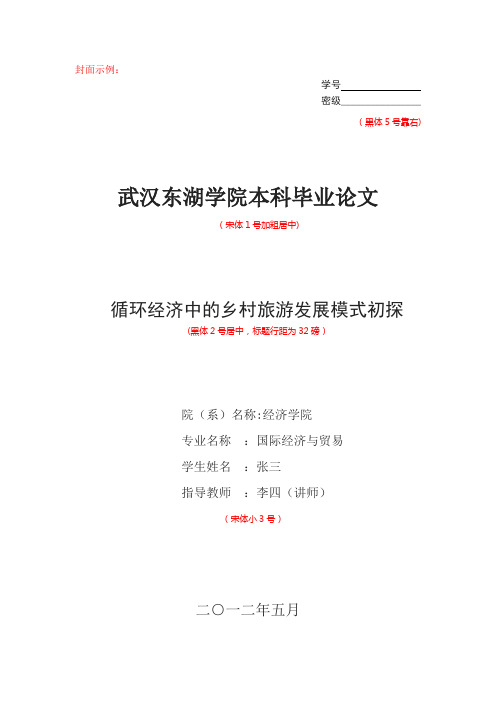
封面示例:学号密级________________(黑体5号靠右)武汉东湖学院本科毕业论文(宋体1号加粗居中)循环经济中的乡村旅游发展模式初探(黑体2号居中,标题行距为32磅)院(系)名称:经济学院专业名称:国际经济与贸易学生姓名:张三指导教师:李四(讲师)(宋体小3号)二○一二年五月(宋体小2号居中)BACHELOR’S DEGREE THESISOF WUHAN DONGHU COLLEGE(Times New Roman 2号加粗居中)The development model of rural tourism inrecycling economy(Times New Roman 2号加粗居中)College :Donghu college of Wuhan UniversitySubject :Name :Directed by :(Times New Roman 4号居中)May 2012(Times New Roman小2号居中)郑重声明(宋体2号加粗居中,字间距1字符)本人呈交的学位论文,是在导师的指导下,独立进行研究工作所取得的成果,所有数据、图片资料真实可靠。
尽我所知,除文中已经注明引用的内容外,本学位论文的研究成果不包含他人享有著作权的内容。
对本论文所涉及的研究工作做出贡献的其他个人和集体,均已在文中以明确的方式标明。
本学位论文的知识产权归属于培养单位。
(宋体4号)本人签名:日期:(宋体4号)中文摘要示例:摘□□要(黑体小2号居中,字间隔两字符)循环经济理论的内涵是在经济活动中实施减量化、再利用和资源化生产,开展无害化管理和环境友好消费.旅游业是以资源和环境为依托的产业,要求以环境友好方式利用各类资源,实现旅游经济活动生态化,这与循环经济本质一致.乡村旅游资源的开发利用,应遵循循环经济的减量化(Reduce)、再利用(Reuse)、再循环(Recycle)原则,合理规划,系统地减少和避免资源的破坏,从根本上减少和避免旅游废弃物的排放,以实现其可持续发展.我国乡村旅游发展中暴露出的问题,有悖于循环经济理论和可持续发展理念。
英语本科毕业论文格式规范
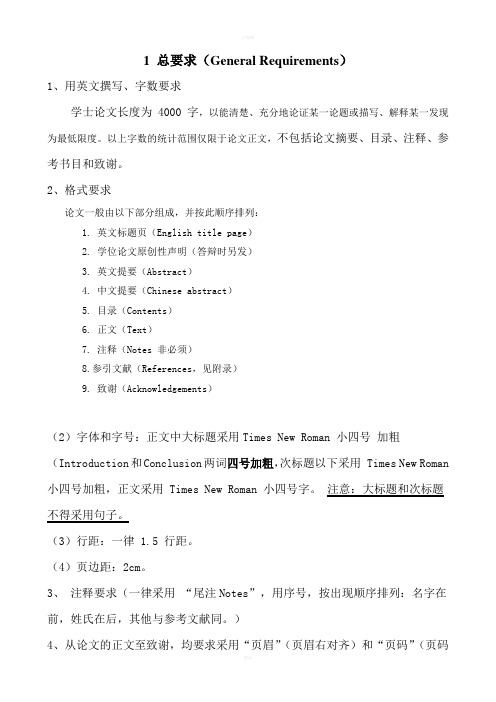
1 总要求(General Requirements)1、用英文撰写、字数要求学士论文长度为 4000 字,以能清楚、充分地论证某一论题或描写、解释某一发现为最低限度。
以上字数的统计范围仅限于论文正文,不包括论文摘要、目录、注释、参考书目和致谢。
2、格式要求论文一般由以下部分组成,并按此顺序排列:1. 英文标题页(English title page)2. 学位论文原创性声明(答辩时另发)3. 英文提要(Abstract)4. 中文提要(Chinese abstract)5. 目录(Contents)6. 正文(Text)7. 注释(Notes 非必须)8.参引文献(References,见附录)9. 致谢(Acknowledgements)(2)字体和字号:正文中大标题采用Times New Roman 小四号加粗(Introduction和Conclusion两词四号加粗,次标题以下采用 Times New Roman 小四号加粗,正文采用 Times New Roman 小四号字。
注意:大标题和次标题不得采用句子。
(3)行距:一律 1.5 行距。
(4)页边距:2cm。
3、注释要求(一律采用“尾注Notes”,用序号,按出现顺序排列:名字在前,姓氏在后,其他与参考文献同。
)4、从论文的正文至致谢,均要求采用“页眉”(页眉右对齐)和“页码”(页码应居中)。
并在目录中标出。
封面(空两行;页边距为2cm)(Please write the English title of your thesis here)(Arial 一号加粗居中)(Please write the Chinese title of your thesis here)(宋体一号加粗居中)(空两行)Submitted by (Please write your name here) (Arial 三号加粗居中)Student number ( Please write your ID here ) (Arial 三号加粗居中)Supervised by (Please write the name of your tutor here) (Arial 三号加粗居中)(空两行)Foreign Languages College(Arial 小三号加粗居中)Jiangxi Normal University(Arial 小三号加粗居中)(Insert Month here) (Insert Year here) (Arial 小三号加粗居中)Title of the thesis(Times New Roman 三号粗体居中)(空一行)Abstract(Times New Roman 小四号加粗):正文(Times New Roman 小四号)………………………………………………………………………………………………………(空一行)Key words(Times New Roman 小四号加粗):正文(Times New Roman 小四号)…………………………………………………………………………………………摘要之后另起一行,给出论文的关键词3-5个(关键词要用分号“;” 分隔,结束不用句号,关键词不能超过5个)中文题目(宋体三号粗体居中)(空一行)摘要(宋体小四号加粗):正文(宋体小四号)………………………………………………………………………………………………………………………………………(空一行)关键词(宋体小四号加粗):正文(宋体小四号)………………………………………………………………………………………………(用分号“;”分隔,结束不用句号,)(空一行)提要格式要求:1、中文、英文摘要分页打印2、A4纸打印3、页边距:2cm4、行距:1.5倍行距Contents (Times New Roman 三号粗体居中)(空两行)Abstract (i)摘要 (ii)Introduction (1)1. ……………………………………………………………………………………1.1 ……………………………………………………………………………………1.2 …………………………………………………………………………………..2. ……………………………………………………………………………………..2.1 …………………………………………………………………………………..2.2 …………………………………………………………………………………..2.3 ……………………………………………………………………………………3. …………………………………………………………………………………….…Notes………………………………………………………………………………………….. Bibliography…………………………………………………………………………………. Acknowledgements……………………………………………………………………………目录格式要求:目录要自动生成!!所有标题都设为一级标题并顶格排列1、字体要求:Times New Roman 小四号粗体2、A4纸打印3、页边距:2cm4、行距:1.5倍行距5、论文内容排序:封面—声明—Abstract—摘要—Contents—正文—尾注—参考文献—致谢(空一行)Introduction (Times New Roman 四号加粗居中)(空一行)(5spaces) 正文……………………………………………………………………………………………………………………………………………………………………………(空一行)1 (Times New Roman小四号加粗)(5spaces) 正文……………………………………………………………………………………………………………………………………………………………………………1.1(Times New Roman小四号加粗)(5spaces) 正文……………………………………………………………………………………………………………………………………………………………………………1.1.1(Times New Roman小四号加粗)(5spaces) 正文………………………………………………………………………………………………………………………………………………………………………1.1.2(Times New Roman小四号加粗)(5spaces) 正文…………………………………………………………………………………………………………………………………………………………………………1.2(Times New Roman小四号加粗)(5spaces) 正文………………………………………………………………………………………………………………………………………………………………………1.2.1(Times New Roman小四号加粗)(5spaces) 正文………………………………………………………………………………………………………………………………………………………………………1.2.2(Times New Roman小四号加粗)(5spaces) 正文……………………………………………………………………………………………………………………………………………………………………2 (Times New Roman小四号加粗)(5spaces) 正文……………………………………………………………………………………………………………………………………………………………………………2.1(Times New Roman小四号加粗)(5spaces) 正文……………………………………………………………………………………………………………………………………………………………………………2.1.1(Times New Roman小四号加粗)(5spaces) 正文………………………………………………………………………………………………………………………………………………………………………2.1.2(Times New Roman小四号加粗)(5spaces) 正文…………………………………………………………………………………………………………………………………………………………………………2.2(Times New Roman小四号加粗)(5spaces) 正文………………………………………………………………………………………………………………………………………………………………………2.2.1(Times New Roman小四号加粗)(5spaces) 正文………………………………………………………………………………………………………………………………………………………………………2.2.2(Times New Roman小四号加粗)(5spaces) 正文……………………………………………………………………………………………………………………………………………………………………3 (Times New Roman小四号加粗)4 (Times New Roman小四号加粗)…Conclusion(Times New Roman 四号加粗居中)(5spaces) 正文………………………………………………………………………………………………………………………………………………………………………(另起一页)Notes(Times New Roman 四号加粗居中)正文(Times New Roman 小四号)[1]作者,书名(英文书名格式为Times New Roman小四号斜体;中文书名格式为《宋体小四号》),出版社,出版时间:页码.(有一实心点作为句号)[2]如出处同上一个注释,则标为ibid(空一格)(页码).[3]……(另起一页)Bibliography(Times New Roman 四号加粗居中)英文参考书目(按首写字母顺序排列)网络参考资料中文参考书目(按汉语拼音顺序排列)参考文献写作规范1.说明(1)文献目录应另页书写,外文文献排前,中文文献排后。
英文合同摘要模板范文
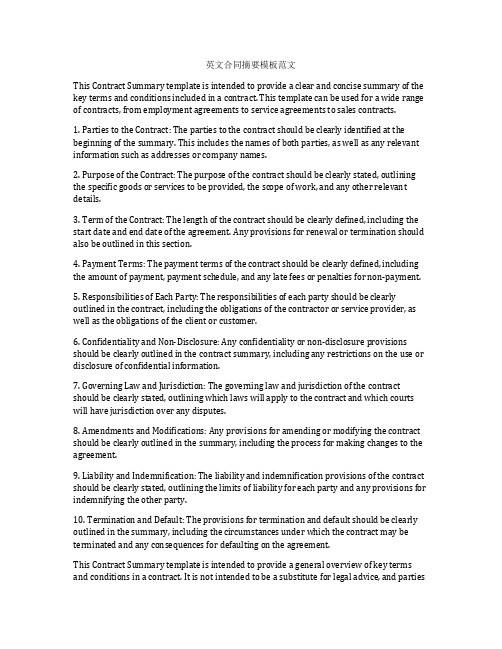
英文合同摘要模板范文This Contract Summary template is intended to provide a clear and concise summary of the key terms and conditions included in a contract. This template can be used for a wide range of contracts, from employment agreements to service agreements to sales contracts.1. Parties to the Contract: The parties to the contract should be clearly identified at the beginning of the summary. This includes the names of both parties, as well as any relevant information such as addresses or company names.2. Purpose of the Contract: The purpose of the contract should be clearly stated, outlining the specific goods or services to be provided, the scope of work, and any other relevant details.3. Term of the Contract: The length of the contract should be clearly defined, including the start date and end date of the agreement. Any provisions for renewal or termination should also be outlined in this section.4. Payment Terms: The payment terms of the contract should be clearly defined, including the amount of payment, payment schedule, and any late fees or penalties for non-payment.5. Responsibilities of Each Party: The responsibilities of each party should be clearly outlined in the contract, including the obligations of the contractor or service provider, as well as the obligations of the client or customer.6. Confidentiality and Non-Disclosure: Any confidentiality or non-disclosure provisions should be clearly outlined in the contract summary, including any restrictions on the use or disclosure of confidential information.7. Governing Law and Jurisdiction: The governing law and jurisdiction of the contract should be clearly stated, outlining which laws will apply to the contract and which courts will have jurisdiction over any disputes.8. Amendments and Modifications: Any provisions for amending or modifying the contract should be clearly outlined in the summary, including the process for making changes to the agreement.9. Liability and Indemnification: The liability and indemnification provisions of the contract should be clearly stated, outlining the limits of liability for each party and any provisions for indemnifying the other party.10. Termination and Default: The provisions for termination and default should be clearly outlined in the summary, including the circumstances under which the contract may be terminated and any consequences for defaulting on the agreement.This Contract Summary template is intended to provide a general overview of key terms and conditions in a contract. It is not intended to be a substitute for legal advice, and partiesshould seek the advice of a qualified attorney before entering into any contractual agreement.。
论文中英文摘要的写作

概述
文章摘要是对所写文章主要内容的精炼概括。美国人称摘 要为“Abstract”,而英国人则喜欢称其为“Summary”。 国际会议要求的论文摘要的字数不等,一般为200字-500 字。而国际刊物要求所刊登的论文摘要的字数通常是100 字-200字。摘要的位置一般放在一篇文章的最前面,内容 上涵盖全文,并直接点明全旨。语言上要求尽量简炼。摘 要通常多采用第三人称撰写。 科学书籍、论文和学术报告一般都附有内容摘要,这样可 以节省读者的时间,使他们不必读完整个文章就能够了解 它的主要内容。书籍摘要,一般放在封二或封三;论文和 学术报告的摘要,一般放在正文前面。
15)This paper strongly emphasizes... 16)This essay represents the proceedings of ... 17)This article not only describes...but also suggests... 18)This paper considers.. 19)This paper provides a method of ... 20)This paper introduces an applicable procedure to analyze... 21)This paper offers the latest information regarding... 22)This paper is devoted to examining the role of... 23)This article explores... 24)This paper expresses views on... 25)This paper reflects the state of the art in... 26)This paper explains the procedures for... 27)This paper develops the theory of ... 28)This article reviews the techniques used in...
英语论文格式与引用注释规范
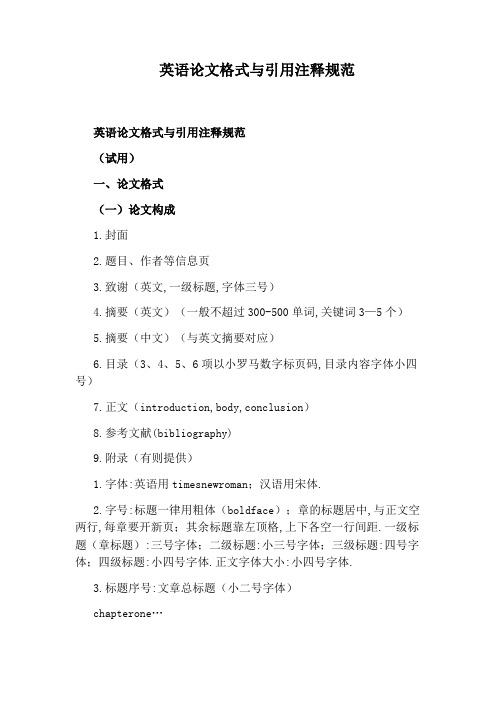
英语论文格式与引用注释规范英语论文格式与引用注释规范(试用)一、论文格式(一)论文构成1.封面2.题目、作者等信息页3.致谢(英文,一级标题,字体三号)4.摘要(英文)(一般不超过300-500单词,关键词3—5个)5.摘要(中文)(与英文摘要对应)6.目录(3、4、5、6项以小罗马数字标页码,目录内容字体小四号)7.正文(introduction,body,conclusion)8.参考文献(bibliography)9.附录(有则提供)1.字体:英语用timesnewroman;汉语用宋体.2.字号:标题一律用粗体(boldface);章的标题居中,与正文空两行,每章要开新页;其余标题靠左顶格,上下各空一行间距.一级标题(章标题):三号字体;二级标题:小三号字体;三级标题:四号字体;四级标题:小四号字体.正文字体大小:小四号字体.3.标题序号:文章总标题(小二号字体)chapterone…1.11.1.11.1.1.1…2.12.1.14.引文:少于四行的直接引文置于双引号内;超过四行(包括四行)的引文要与正文隔开,上下各空一行,左边缩进10个字母;如所引原文第一行有缩进,则该行在论文中再缩进三个字母的间距,即引文第一行缩进13个字符;字体小1号使用(即五号字体);行距为1.5.图表:图表应有与内容相符的明确标题;图的标记以第二章图一为例则为:figure2—1,依此类推;表的标记以第二章表一为例则为:table2—1,依此类推.6.行距:除四行及以上引文行距为1外,全文为1.25倍或18磅.二、引文注释规范1.注释或引用分为文内注和文末参考文献两种形式.文内注置于圆括号内,紧跟在引用内容之后;应标出作者姓(名)和页码,之间不用标点,如(bhabha120),若同一作者有多部著作引用,则应在作者姓后分别注出该著作出版年份,如,(weiss1998:76)、(weiss2002:104),等.若在文内已提供被引用者姓名,则只要将引文页码置于圆括号内.若引文文献著者有同姓者,应提供其名的首字母.若著者为多位,可在第一位著者姓之后用“等等”(etal.),也可提供所有著者姓,之间用逗号分隔.若著者为汉语姓氏,提供汉字全名,以免混淆.若引文页码有起止范围,在起止页码之间用单横线连接;若页码有两个及以上,中间用逗号分隔.若引用为间接来源,则应第一引用者姓(名)前注出“转引自”(qtd.in)字样.文内注示例:briantavessuggestssomeinterestingconclusionsregardingthe philosophyandpoliticsoftheadventurefilm(153-54,171).georgemayberry,writinginthenewrepublic,referredto itasa“deeplyandtragicallyhuman”story(108);andedwinj.lukas,inthea nnalsoftheamericanacademyofpoliticalandsocialscience,hailed itasessentialreadingforprofessionalsconcernedwiththecrimina lpersonality(216).theauthorsofwomen’swaysofknowingmakeadistinctionbetween “separateknowing”and“connectedknowing”(belenkyetal.100-30).(多位作者也可以注出所有著者姓,中间用逗号分隔.)。
英文摘要标题 Time New Roman大写粗体小2号

一、内容要求1.题目:应精练、准确地概括论文研究的主要内容和结果,一般不宜超过20字。
2.中文摘要:在主体内容前用300-500字的中文扼要介绍论文的主要内容、采用的研究方法和得到的主要结论。
3.关键词:按与论文内容紧密程度依次列出3-5个关键词。
4.英文摘要与关键词:内容与中文摘要相同。
最后一行注明论文的关键词(3-5个)。
5.目录:应是论文的提纲,也是论文的小标题。
文字应简明扼要。
目录按论文顺序分章、节二级编写,要标明页数,以便阅读。
目录中的标题应与正文中的标题一致。
6.正文一般有以下几个部分组成:(1)引言或背景引言是论文正文的开端,引言应包括毕业论文选题的背景、目的和意义;对国内外研究现状和相关领域中已有的研究成果的简要概述;介绍本项研究工作研究设想、研究方法或实验设计、理论依据或实验基础;涉及范围和预期结果等。
要求言简意赅,注意不要与摘要雷同或成为摘要的注解。
(2)主体论文主体是毕业论文的主要部分,是对研究工作的详细表述,应做到内容充足,概念清楚,思路清晰,逻辑性强;论文中所有文字、图、表、公式、符号等都必须符合国家有关科学论文的要求和规定。
(3)结论结论是毕业论文的总结,是整篇论文的归宿。
着重阐述自己的创造性成果及其在本研究领域中的意义、作用,还可进一步提出需要讨论的问题和建议。
结论要简单、明确,篇幅不宜过长。
7.参考文献(不少于15篇,外文文献不少于2篇):毕业论文的撰写应本着严谨求实的科学态度,凡有引用他人成果之处,均应按论文中所引用的顺序列于文末,并且所有参考文献必须在正文中有引用标注。
参考文献的著录均应符合国家有关标准(按照GB7714—2005《文后参考文献著录格式》执行)。
一篇论著在论文中多处引用时,在参考文献中只应出现一次,序号以第一次出现的位置为准。
8.附录:附录是不宜放在正文中的资料,如调查阅卷、公式推演、编写程序、原始数据附表等等。
二、书写与打印规范1.文字和字数除有特殊要求的专业外,毕业论文一般用简化汉语文字撰写,毕业论文的字数人文社科类专业一般不应少于0.8万字,理工类专业一般不应少于0.6万字。
最新中南大学硕士、博士研究生学位论文格式-样例1-10
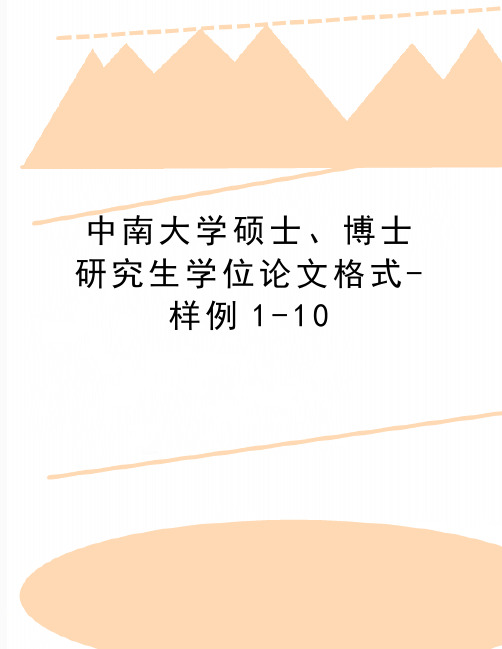
中南大学硕士、博士研究生学位论文格式-样例1-10样例1 公开学位论文封面格式(学术学位博士、硕士):博(或硕)士学位论文(小二号黑体)(学位论文题名,二号黑体)(学位论文英文题名,小二号Times New Roman)学科专业一级学科名称(三号宋体)学科方向二级学科或三级学科名称(三号宋体)【自主设置二级学科和交叉学科须加括号注明,如生命伦理学(自主设置交叉学科)、卫生法学(自主设置二级学科)】作者姓名×××(三号宋体)指导教师×××教授(三号宋体)中南大学(小三号宋体)年月(小三号宋体,填阿拉伯数字)样例2 公开学位论文封面格式(专业学位博士、硕士):博(或硕)士学位论文(小二号黑体)(学位论文题名,二号黑体)(学位论文英文题名,小二号Times New Roman)学科专业专业学位类别名称(专业学位)(如临床医学、工程,三号宋体)专业领域专业学位领域名称(三号宋体)(无领域则可不填)作者姓名×××(三号宋体)指导教师×××教授(三号宋体)中南大学(小三号宋体)年月(小三号宋体,填阿拉伯数字)样例3 涉密学位论文封面格式(学术学位博士、硕士):密级定密日期年月日博士学位论文(小二号黑体)(学位论文题名,二号黑体)(学位论文英文题名,小二号Times New Roman)学科专业一级学科名称(三号宋体)学科方向二级学科或三级学科名称(三号宋体)【自主设置二级学科和交叉学科须加括号注明,如生命伦理学(自主设置交叉学科)、卫生法学(自主设置二级学科)】作者姓名×××(三号宋体)指导教师×××教授(三号宋体)中南大学(小三号宋体)年月(小三号宋体,填阿拉伯数字)样例4 涉密学位论文封面格式(专业学位博士、硕士):密级定密日期年月日博(或硕)士学位论文(小二号黑体)(学位论文题名,二号黑体)(学位论文英文题名,小二号Times New Roman)学科专业专业学位类别名称(专业学位)(如临床医学、工程,三号宋体)专业领域专业学位领域名称(三号宋体)(无专业领域则可不填)作者姓名×××(三号宋体)指导教师×××教授(三号宋体)中南大学(小三号宋体)年月(小三号宋体,填阿拉伯数字)样例5 公开、涉密学位论文扉页(学术学位博士、硕士):中图分类号学校代码 10533UDC 学位类别学术学位博士学位论文(小二号黑体)(学位论文中文题名,小二号黑体)(学位论文英文题名,小二号Times New Roman)作者姓名:×××(三号宋体)学科专业:一级学科名称(三号宋体)学科方向:二级学科或三级学科名称(三号宋体)【自主设置二级学科和交叉学科须加括号注明,如生命伦理学(自主设置交叉学科)、卫生法学(自主设置二级学科)】研究方向:关键词组(三号宋体)二级培养单位:(三号宋体)指导教师:(三号宋体)副指导教师:(必要时,三号宋体)论文答辩日期答辩委员会主席(小三号宋体)(小三号宋体)中南大学(小三号宋体)年月(小三号宋体,填阿拉伯数字)样例6 公开、涉密学位论文扉页(专业学位博士、硕士):中图分类号学校代码 10533UDC 学位类别专业学位博(或硕)士学位论文(小二号黑体)(学位论文中文题名,小二号黑体)(学位论文英文题名,小二号Times New Roman)作者姓名:×××(三号宋体)学科专业:学科类别名称(三号宋体)专业领域:专业学位领域名称(三号宋体)(无专业领域则可不填)研究方向:关键词组(三号宋体)二级培养单位:(三号宋体)指导教师:(三号宋体)副指导教师:(必要时,三号宋体)论文答辩日期答辩委员会主席(小三号宋体)(小三号宋体)中南大学(小三号宋体)年月(小三号宋体,填阿拉伯数字)样例7学位论文原创性声明本人郑重声明,所呈交的学位论文是本人在指导教师指导下进行的研究工作及取得的研究成果。
英文摘要编写应注意几点

英文摘要编写应注意几点①除非数字位于句首,所有数字都采用数字表示(数字位于句首的句子应考虑重新组句).ﻭ②充分利用惯常的简化词语(例如,使用vs.代替versus);所有需要在的正文里进行解释的缩写,在摘要中第一次使用时也要进行说明。
ﻭﻭ③尽量使用主动态(但是不要使用我或者我们之类的人称代词),有助于文字清晰、简洁和表达有力。
ﻭ④使用动词而不要使用动名词。
ﻭﻭﻭ英文摘要示例如下:ﻭStudied the time course of graphic, phonological,a nd semanticactivation in therecogtion of hi ghfreuency Chinese racters.Ss were 120uversity students (Exp 1 and 2)inBeijingNormal Uversi ty,China.The priming—target pairswere in4 types of priming:graphic,phonological, semantic priming,and nonpriming,and thedurations b etween primingand target were at stimulus onset asyn chrony (SOA)43ms, 57 ms, 85 ms,and 145 ms respectively. In Exp 1,thetimecoursewas investigated in asemantic priming category judgment where Ss judged whetherthe targetwas an amal name. In Exp 2,the time course was investigated in a phonological priming category judgment whereSsjudged whether the target was pronounced yi. The time courseof activation wasstudied in an analysis of the priming effects at differentSOAconditions withmultivariate analysis of vari ance(MANOV A).The results showedthat theorder of accessinglexical informationof high freuencyChineseractersis graphic,semantic, and phonological。
